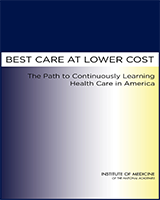From: 8, Achieving and Rewarding High-Value Care

NCBI Bookshelf. A service of the National Library of Medicine, National Institutes of Health.
Tailoring of care for medically complex patients can lead to improved care quality and patient health. One clinic using this model is the AtlantiCare Special Care Center—a clinic established to serve the small percentage of patients with multiple chronic diseases that accounted for the majority of the health care spending of the Local 54 Health and Welfare Fund, a union providing benefits to Atlantic City hospitality industry workers. The benefits of focusing on patients with multiple conditions can be seen in the case of Vibha Gandhi. Vibha, struggling with diabetes, obesity, and heart disease, was confined to her wheelchair and had just suffered her third heart attack. Her physicians had described her advanced coronary artery disease as inoperable just before she visited the Special Care Center for the first time.
Upon checking in, Vibha met with a health coach, Jayshree, who provided support and could connect with Gujarati-speaking patients like Vibhali while care was specially coordinated among the clinic's doctors, nurses, other clinicians, and health coaches. With Jayshree's encouragement, Vibha's health began to improve. She changed her dietary habits, committed to exercise, closely monitored her diabetes, and even took up yoga every Tuesday. Now capable of walking for a quarter mile without losing her breath, Vibha is able to live a sustainable life as a result of intensive monitoring, coaching, and personalized care.
In addition to cases of patients like Vibha, the broad results of the Special Care Center approach have been encouraging. Fully 93 percent of patients offered positive remarks on care coordination, compared with 51 percent under the previous care model. Moreover, 93 percent of patients reported that their clinic doctor seemed to know all the important information about their medical history, compared with 56 percent previously. At the same time, the clinic has increased its patients' rate of prescription drug compliance, lowered patients' smoking rates below the national average through its smoking cessation program, and helped patients lower their LDL (low-density lipoprotein) cholesterol levels by 10 percentage points in just 1 year.
SOURCES: Blash et al., 2010; Gawande, 2011.
From: 8, Achieving and Rewarding High-Value Care

NCBI Bookshelf. A service of the National Library of Medicine, National Institutes of Health.